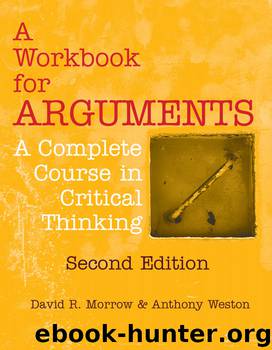A Workbook for Arguments, Second Edition: A Complete Course in Critical Thinking by David R. Morrow & Anthony Weston

Author:David R. Morrow & Anthony Weston
Language: eng
Format: epub
Publisher: Hackett Publishing Company, Inc.
Published: 2015-10-31T16:00:00+00:00
Need more practice? Find news sites on the Web that allow users to comment on news stories. Look for stories on controversial topics and read the comments about those stories. Many of the comments will offer arguments about the news stories, about related (or unrelated) topics, or about other comments. See how many fallacies you can identify in those comments.
Exercise Set 10.4: Reinterpreting and revising fallacious arguments (part 2)
Objective: To give you practice developing productive responses to fallacious arguments.
Instructions: Review each of the arguments in Exercise Set 10.3. If you think the argument commits a fallacy, explain how you could reinterpret, revise, or rewrite the argument to avoid that fallacy, keeping as close to the original content and spirit of the argument as you can. If you think an argument does not commit a fallacy, just write, “No fallacy.”
Tips for success: As in Exercise Set 10.2, your goal here is to offer something more productive than simply diagnosing fallacies. Your response will need to be tailored to the specific fallacies that you identify.
When a conversational partner overlooks alternatives, the most productive response is to point out other salient alternatives and ask whether those alternatives change your partner’s conclusions. Acknowledging those alternatives may force the speaker to give up the argument, since the original argument may not work once he or she takes those alternatives into account. In some cases, however, adding new alternatives doesn’t change the ultimate conclusion. So don’t jump to any conclusions yourself when you notice that someone has overlooked alternatives.
When someone uses loaded language in presenting an argument, ask yourself what you would think of the argument if all of the loaded language were replaced with neutral language. Just because an argument is {247} couched in loaded language doesn’t necessarily mean that it’s a bad argument. It just means that you need to beware of getting carried away by emotion when you evaluate the argument. The same goes for poisoning the well. Ask yourself what you would think of the person’s claim or argument if he or she had not “poisoned the well” by associating the claim or argument with something unsavory.
What looks like a non sequitur to you might look like a strong argument to someone who knows some additional information that links the argument’s premises to its conclusion. If you suspect that someone’s argument is a non sequitur, ask for clarification rather than attacking the argument. If the author isn’t available to clarify the argument for you, see if you can fill in any missing premises yourself. What must the author be assuming if he or she takes the premises of the argument to be good reasons for the conclusion? Are those assumptions defensible?
Someone who appears to be generalizing from one or two examples might simply have offered those examples as illustrations, not evidence. Ask yourself or the argument’s author whether there are other plausible reasons to think that the generalization is true. Giving other reasons might involve giving additional examples, but it might involve other strategies, such as citing sources.
Download
This site does not store any files on its server. We only index and link to content provided by other sites. Please contact the content providers to delete copyright contents if any and email us, we'll remove relevant links or contents immediately.
The remains of the day by Kazuo Ishiguro(8338)
Tools of Titans by Timothy Ferriss(7735)
Giovanni's Room by James Baldwin(6747)
The Black Swan by Nassim Nicholas Taleb(6719)
Inner Engineering: A Yogi's Guide to Joy by Sadhguru(6404)
The Way of Zen by Alan W. Watts(6253)
Asking the Right Questions: A Guide to Critical Thinking by M. Neil Browne & Stuart M. Keeley(5319)
The Power of Now: A Guide to Spiritual Enlightenment by Eckhart Tolle(5291)
The Six Wives Of Henry VIII (WOMEN IN HISTORY) by Fraser Antonia(5197)
Astrophysics for People in a Hurry by Neil DeGrasse Tyson(4972)
12 Rules for Life by Jordan B. Peterson(4138)
Housekeeping by Marilynne Robinson(4016)
The Ethical Slut by Janet W. Hardy(4006)
Skin in the Game by Nassim Nicholas Taleb(3941)
Double Down (Diary of a Wimpy Kid Book 11) by Jeff Kinney(3873)
Ikigai by Héctor García & Francesc Miralles(3829)
The Art of Happiness by The Dalai Lama(3817)
Skin in the Game: Hidden Asymmetries in Daily Life by Nassim Nicholas Taleb(3695)
Walking by Henry David Thoreau(3657)
